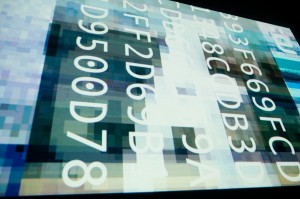I have an early memory of playing on a typewriter upstairs at my father’s office. While I was old enough to have typed words or even a short story, my first impulse was to use the machine to layer and mix mostly non-alphanumeric characters (periods, brackets, commas, etc.), combining the red and black strips of ink to create what I proudly presented to my mother as “my own language”. I knew then on some level that what I had created was and was not language at the same time.
In my recent art projects I have explored the visual output of both past civilizations in the form of petroglyphs, and contemporary computer coding languages in the form of obscure characters. Both systems of glyphs are nearly completely unintelligible to the layperson and remain obscure even to the specialist. Thus, these systems have an inherent relationship with semiotics, as the associations between the characters and symbols fail to create meaning. While one function of code is to communicate, another equally useful purpose is to obfuscation (as in Morse code, etc.). Many children are attracted to this capability of code and language, evidenced by the marketing of secret decoder rings and fake spy gear.
A basic principle of semiotics is that meaning is constructed through difference [1. Saussure, Ferdinand De, Charles Bally, Albert Sechehaye, and Albert Riedlinger. Course in General Linguistics. LaSalle, IL: Open Court, 1986. Print.]. In the world of computer languages, fragmentary, rigidly organized, intensely fragile components cannot even be understood in terms of difference, for difference is found in such abundance between coding languages and within any specific language that difference is completely stripped of its organizing power. It doesn’t really make sense to call computer programming languages “languages” at all, in that while they have a metaphorical resemblance to human language, they are essentially data systems of commands that are not spoken nor written, save to transmit information to machines. This misleading resemblance is what makes code so frustrating for the uninitiated and so intriguing for me visually.
Taking a huge leap back in time, petroglyphs or rock carvings are also systems of information but not necessarily language either. When I first stumbled on some petroglyphs in and around Joshua Tree National Park I was struck both by their art-ness and their resemblance to written language.
These symbols are often referred to as “rock art”. There is an undeniable formal beauty in the line work and abstract renderings of these peoples, and it is easy to feel an artistic connection.
Most of the Joshua Tree markings belong to the Great Basin Abstract style and are believed to have been carved by by the Serrano or Cahuilla Native Americans several thousand years ago [2. Austin, Donald. “Serrano Petroglyphs at Coyote Hole, Joshua Tree, California.” Petroglyphs, Pictographs and Rock Art. Petroglyphs.us, 3 Jan. 2006. Web. 24 Mar. 2013.]. But beyond their physical appearance, we know little about them. There is no reliable way to carbon date a rock carving, since the carving is literally the absence of rock, and the rock itself predates humans. Furthermore, sites may contain carvings from multiple tribes or carvings made at different times. Most individual meanings of the markings are lost to time.
In my most recent web project I use JavaScript code to randomly generate an array of images of glyphs arranged into a grid. Clicking on one of the glyphs advances the user to the next page, but the correct choice is a mystery. While the grid evokes modernist notions of organization and understanding, the random placement of the glyphs underscores their unintelligibility.













